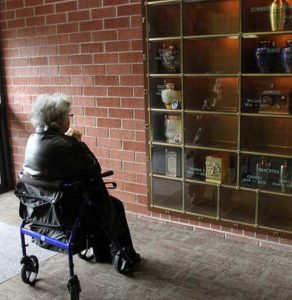ST. FRANCIS — The Catholic Church teaches life is sacred, from conception to natural death – and after natural death, the earthly vessel had housed the soul, is to be accorded the greatest of respect.

Families can have cremated remains of departed loved ones committed to “the Crypt of All Souls” for permanent storage within the consecrated grounds of archdiocesan cemeteries. (thinkstock.com image)
In honor of that teaching, the archdiocese is offering to southeastern Wisconsin families of all faiths the opportunity to inter the cremated remains of their loved ones in a community crypt at Holy Cross Cemetery.
This Day of Remembrance service, provided free of charge, will begin at 9 a.m. on All Souls Day, Wednesday, Nov. 2. Archbishop Listecki will celebrate Mass at 8:30 a.m.
The cremated remains of the departed will be committed to “the Crypt of All Souls” for permanent storage within the consecrated grounds of the archdiocesan cemeteries. Families can also have their loved one’s name inscribed on a cenotaph near the crypt, in exchange for a donation to the cemetery. If the families wish to disinter the remains for a funeral service at some point in the future, that service will also be done at no cost.
According to organizers, this event is aimed at underscoring the importance of one of the corporal works of mercy – burying the dead. The Year of Mercy provides the faithful with a perfect opportunity to do this, said Robert Seelig, CEO of Catholic Management Services (CMS).
CMS, a non-profit corporation operating under the auspices of the Diocese of Oakland, California, assumed responsibility for the cemeteries of the Archdiocese of Milwaukee this summer.
Seelig and CMS have adapted programs of this kind in 20 dioceses throughout the country with which they work, he said. As more people opt for cremation, it is of increasing concern to the church that many of the faithful are not aware of the prescribed treatment of cremated remains.
This year, the National Funeral Directors Association reported that in 2015 the number of cremations surpassed the number of burials. The projected rate of cremations for the year 2030, according to the same report, is 71 percent of all deaths.[su_pullquote align=”right”]For more information on the Day of Remembrance, visit tinyurl.com/soulsremembrance. For those interested in participating, interment arrangements must be finalized by 5 p.m. Wednesday, Oct. 26.[/su_pullquote]
Still, Seelig reported that cemeteries nationwide are seeing a dip in revenue even as the baby boomer generation is beginning to pass. This means that a great number of families are choosing to ignore church teaching, taking cremated remains home and displaying them on shelves or even storing them in closets.
Though the 1983 Code of Canon Law allows for cremation, Barbara Anne Cusack, chancellor of the Archdiocese of Milwaukee, said it is important for Catholics to remember the ashes of their loved one must be treated with all the respect and reverence that would be accorded an intact body.

Laure Cressaty prays in front of a niche holding the cremated remains of her late husband, Joseph Cressaty, at Holy Rood Cemetery in Westbury, New York, Oct. 21, 2014. (CNS file photo/Gregory A. Shemitz)
Actions that include displaying the ashes in a home or scattering them outdoors are not acceptable, she said.
“You ask yourself, would I do this – whatever the action is – with the deceased’s body? And if the answer is no, then you don’t do that with the cremated remains,” she said.
“Even though the church has a prescribed approach – having the body present at a funeral Mass and interring the remains in a cemetery – the fact that you can do cremation kind of allows a family to go a different path (against church teaching),” said Seelig. “They can take the remains home, choose to have a funeral two months later – it’s been a significant issue in the Catholic Church.”
He described cremation as the opportunity to not let go.
“You’re not putting a body in the ground. If you felt close to your mom, it would be very easy to bring her home and have a place for her in the home as you deal with your grief. And as you transition, Mom is still there. Six months later, she might have moved to a bedroom. At some point she might even move to a closet,” said Seelig.
What is problematic is that cremation might lessen the urgency a family feels to care for the remains of the deceased.
“One of our concerns is that while an immediate family member may say, ‘Well, I’m going to take care of this later,’ we’ve heard of too many stories where that family member no longer is around, no longer in the home where the cremated remains are, and so no one is taking care of the respectful disposition of what was a temple of the Holy Spirit,” said Cusack.
In one archdiocese where CMS operates, Seelig said a recent survey of funeral directors revealed that the cremated remains of over 4,000 people are held by funeral homes, unclaimed by family members.
It is to avoid these situations that the church imposes the Order of Christian Funerals, he said. This rite is divided into three main events – a vigil, funeral Mass and committal service.
“If a priest were to explain it to a family, he would talk about the fact that the vigil allows us to gather and face the fact that we’ve lost somebody. When we enter into the funeral Mass, it’s a more solemn moment – we’re now moving past the gathering moment, processing back into the life of the church,” said Seelig. “Then we proceed to the cemetery where the committal service has very blunt, stark words saying that this person has died. We leave them here, and we almost walk away in a final confrontation of that. It’s to help us through the fact that emotionally, we’ve lost somebody. We’re praying for them but at the same moment speaking to our own faith.”
‘Catholics are confused about this teaching’
Organizers of the event stress there is no judgment placed on anyone who avails themselves of the opportunity to commit their loved one’s remains, no matter how long they have kept them at home.
“Some folks are shy about going to the cemeteries to seek interment after so long. Nobody wants to feel scolded as they walk in the door,” said Seelig. “Catholics are confused about this teaching and we don’t really have a catechetical program for it. As people enter the church, we’re not necessarily taking them through this in RCIA (Rite of Christian Initiation of Adults).”
Parish priests are often too overwhelmed with work to preach on the subject, he said, and even Catholic funeral directors might not be well versed on the rules. The faithful do not usually have an opportunity to interact with the Order of Christian Funeral unless they are grieving – not an ideal situation for catechesis.
With programs like the Day of Remembrance, CMS hopes to give Catholics and non-Catholics alike an opportunity to come into contact with church teaching on end-of-life issues.
“The church is the moral authority on end-of-life issues. We as Catholics know that, but we don’t necessarily take our rightful place in the public eye,” Seelig said. “The Catholic cemetery has a role to do the same thing around the corporal work of mercy of burying the dead.”
